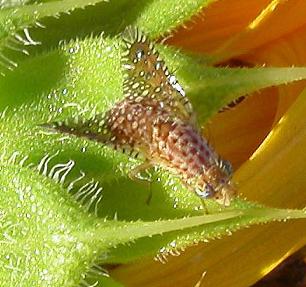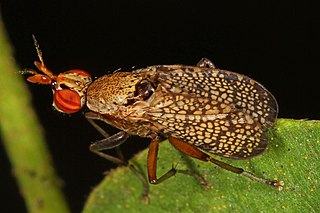
The Drosophilidae are a diverse, cosmopolitan family of flies, which includes fruit flies. Another unrelated family of flies, Tephritidae, also includes species known as "small fruit flies". The best known species of the Drosophilidae is Drosophila melanogaster, within the genus Drosophila, and this species is used extensively for studies concerning genetics, development, physiology, ecology and behaviour. This fruit fly is mostly composed of post-mitotic cells, has a very short lifespan, and shows gradual aging. As in other species, temperature influences the life history of the animal. Several genes have been identified that can be manipulated to extend the lifespan of these insects. Additionally, Drosophila subobscura, also within the genus Drosophila, has been reputed as a model organism for evolutionary-biological studies.

The Scathophagidae are a small family of Muscoidea which are often known as dung flies, although this name is not appropriate except for a few species of the genus Scathophaga which do indeed pass their larval stages in animal dung. The name probably derives from the yellow dung fly, which is one of the most abundant and ubiquitous flies in many parts of the Northern Hemisphere.

The Chamaemyiidae are a small family of acalyptrate flies with less than 200 species described worldwide. The larvae of these small flies are active and predatory and are often used for biological control of aphids, scale insects, and similar pests. Chamaemyiid fossils are poorly represented in amber deposits, but a few examples are known from the Eocene epoch onwards.

Paracantha is a genus of fruit flies in the family Tephritidae. There are about 10 described species in Paracantha.

The Limnophorini are a tribe of flies, belonging to the family Muscidae. Although the name-giving genus is Limnophora, this was actually described only after the more characteristic and easily recognized Lispe.

Actia is a genus of large flies in the family Tachinidae.
Homaluroides is a genus of grass flies in the family Chloropidae. There are about 9 described species in Homaluroides.
Liohippelates is a genus of eye gnats in the family Chloropidae. There are about 11 described species in Liohippelates.
Malloewia is a genus of frit flies in the family Chloropidae. There are about 8 described species in Malloewia.
Olcella is a genus of frit flies in the family Chloropidae. There are about 11 described species in Olcella.
Parectecephala is a genus of grass flies in the family Chloropidae. There are about 6 described species in Parectecephala.
Pseudogaurax is a genus of parasitic chloropid flies in the family Chloropidae. There are at least 4 described species in Pseudogaurax.

Tricimba is a genus of frit flies in the family Chloropidae. There are about 7 described species in Tricimba.

Oxycera is a genus of soldier flies in the family Stratiomyidae. There are at least 80 described species in Oxycera.
Phytoliriomyza is a genus of leaf miner flies in the family Agromyzidae. There are at least 20 described species in Phytoliriomyza.

Tetanocerini is a tribe of flies in the family Sciomyzidae. There are at least 120 described species in the tribe.
Leucopis is a genus of flies in the family Chamaemyiidae. There are at least 20 described species in Leucopis.
Pachyceramyia robusta is a species of house fly the family Muscidae.
Sepedomerus is a genus of marsh flies. There are at least four described species in Sepedomerus.
Probezzia is a genus of biting midges in the family Ceratopogonidae. There are at least 20 described species in Probezzia.







